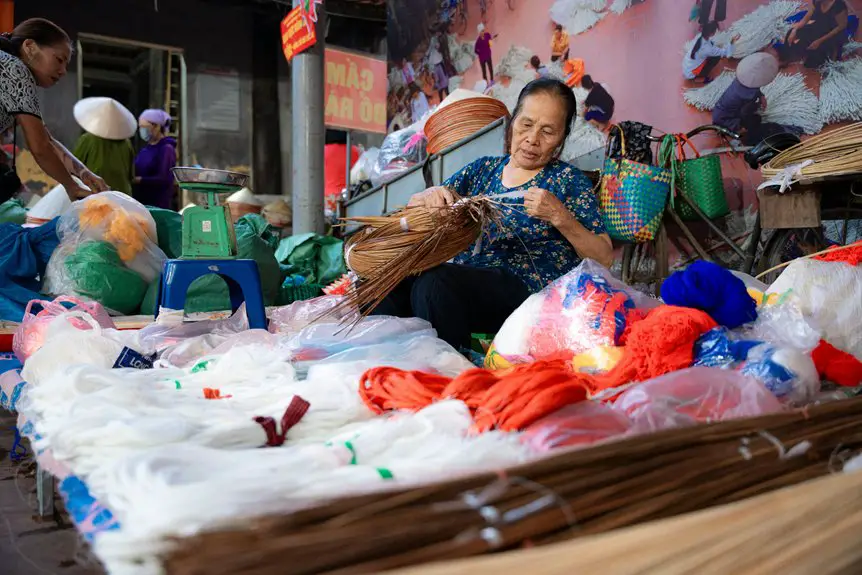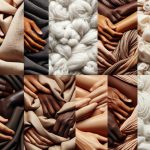You might assume moisture-wicking fabrics are perfect for workouts or daily wear, but they come with some drawbacks you should consider. From potential skin irritation caused by chemical treatments to environmental impacts during production, these fabrics aren’t without flaws. Plus, their performance can vary depending on conditions, and maintenance isn’t always straightforward. Before you fully commit, it’s worth understanding what challenges you might face.
Table of Contents
Key Takeaways
- Chemical treatments in moisture-wicking fabrics may cause skin irritation or allergic reactions in sensitive individuals.
- Production involves harmful chemicals and high resource use, leading to environmental pollution and waste challenges.
- Performance declines in high humidity and cold weather, limiting effective temperature regulation.
- Fabrics can cling uncomfortably and cause chafing or static cling, impacting wearer comfort.
- Frequent washing degrades fabric performance and durability, requiring special care to maintain benefits.
Health Risks Linked to Chemical Treatments
Although moisture-wicking fabrics keep you dry, they often rely on chemical treatments that can pose health risks. You mightn’t realize that these treatment processes use substances designed to repel water and sweat, but some chemicals can cause skin irritation or allergic reactions.
Prolonged chemical exposure, especially if you have sensitive skin, increases the chance of rashes or discomfort. Additionally, certain treatments may release volatile organic compounds (VOCs) during manufacturing or wear, which can affect your respiratory health.
While manufacturers aim to make fabrics safe, the variety and intensity of chemical exposure differ widely. To protect yourself, look for moisture-wicking gear labeled as free from harmful chemicals or seek out natural alternatives. Staying informed helps you balance performance with your health.
Environmental Consequences of Production
When you choose moisture-wicking fabrics, it’s important to contemplate the chemical pollution released during their production.
These processes often consume large amounts of water and energy, straining natural resources.
Understanding these impacts helps you make more environmentally conscious decisions.
Chemical Pollution Impact
Because moisture-wicking fabrics often rely on synthetic materials like polyester and nylon, their production releases harmful chemicals into the environment. You should know that chemical exposure from dyeing, finishing, and treating these fabrics contributes to pollution sources contaminating air and water. This not only affects ecosystems but also poses health risks to factory workers and nearby communities. Here’s a quick look at typical chemicals and their impacts:
| Chemical | Pollution Source | Impact |
|---|---|---|
| Formaldehyde | Finishing treatments | Respiratory irritant |
| Phthalates | Plasticizers | Hormone disruption |
| Heavy metals | Dyes and pigments | Toxic to aquatic life |
| Volatile organics | Solvent use | Air pollution |
| Perfluorinated compounds | Water-repellent coating | Persistent pollutants |
Being aware of these helps you understand the hidden costs behind moisture-wicking fabrics.
Resource Consumption Concerns
How much water and energy do you think go into making moisture-wicking fabrics? The production process often involves significant resource depletion, especially of water and raw materials.
You mightn’t realize that manufacturing synthetic fibers like polyester demands high energy consumption, contributing to environmental strain. This energy use mainly comes from non-renewable sources, increasing carbon emissions.
Additionally, dyeing and finishing these fabrics require large water volumes, exacerbating resource depletion in already water-stressed regions.
When you choose moisture-wicking clothing, it’s important to take into account these hidden environmental costs. While these fabrics offer comfort and performance, their production impacts the planet through intensive energy consumption and resource use.
Being aware helps you make more informed choices and encourages brands to adopt sustainable practices.
Performance Challenges in Different Conditions
Although moisture-wicking fabrics excel in many scenarios, they don’t always perform well across all conditions. You might notice issues with temperature regulation when humidity levels are extreme. When it’s very humid, these fabrics struggle to evaporate sweat efficiently, reducing their cooling effect. Conversely, in cold, dry weather, they might not trap enough warmth, leaving you feeling chilly.
| Condition | Performance Issue |
|---|---|
| High Humidity | Reduced sweat evaporation |
| Cold Weather | Insufficient insulation |
| Variable Temps | Inconsistent temperature control |
Potential Discomfort and Skin Sensitivity
You might find moisture-wicking fabrics cling uncomfortably to your skin, especially when damp.
Some materials also contain chemicals that can cause irritation or allergic reactions.
It’s important to contemplate how these factors could affect your comfort during wear.
Fabric Cling Issues
Because moisture-wicking fabrics are designed to cling closely to your skin, they can sometimes cause discomfort or irritation. The fabric fit is essential; if the garment is too tight, you might feel restricted or experience chafing during movement.
On the other hand, if it’s too loose, you lose the moisture-wicking benefits. Another issue is static cling, which can make the fabric stick awkwardly to your body or other clothes, leading to annoyance and constant readjusting.
This clinginess might also attract lint or pet hair, making the fabric look untidy. While moisture-wicking materials excel at keeping you dry, their clingy nature means you need to choose the right size and fabric blend carefully to avoid discomfort and maintain comfort throughout your activities.
Chemical Irritation Risks
When moisture-wicking fabrics contain certain chemical treatments, they can cause irritation or sensitivity on your skin.
These fabrics often use chemicals to enhance their moisture management, but if you have chemical sensitivity, you might experience discomfort or redness. Some people develop allergenic reactions, including itching or rash, especially if the fabric stays close to your skin for long periods.
If you’re prone to sensitive skin, it’s a good idea to check fabric labels or opt for moisture-wicking options labeled hypoallergenic or free from harsh chemicals. Washing new garments before wearing them can also reduce residue that might trigger reactions.
Being aware of these risks helps you enjoy moisture-wicking benefits without compromising your skin’s comfort or health.
Durability and Maintenance Issues
Although moisture-wicking fabrics offer great comfort, they often struggle with durability over time. You might notice that repeated washing and exposure to sweat can degrade the fabric’s performance, reducing fabric longevity.
These materials typically require special care—such as gentle washing cycles and avoiding fabric softeners—to maintain their moisture-wicking properties. If you don’t follow these maintenance requirements, the fabric can lose its effectiveness, shrink, or even develop pilling.
Additionally, some moisture-wicking fabrics are more prone to wear and tear compared to traditional cotton, so you’ll need to handle them with extra care. Being aware of these durability and maintenance issues helps you prolong the life of your gear, but you should weigh these factors before relying solely on moisture-wicking clothes.
Cost Considerations for Consumers
Taking care of moisture-wicking fabrics properly can save you money in the long run, but you should also consider the upfront costs before buying.
These fabrics often come with a higher price tag compared to regular materials, so doing a price comparison is essential. When planning your budget, factor in not just the initial cost but also any special detergents or washing methods required.
Here are some key points to keep in mind:
- Higher initial purchase price
- Potential need for specialty detergents
- Limited availability in budget stores
- Replacement costs if fabric wears out faster than expected
- Savings from reduced need for multiple clothing layers
Technological and Sustainability Limitations
Because moisture-wicking fabrics rely on advanced synthetic fibers and treatments, they often come with technological and sustainability drawbacks you should consider. While technological advancements improve performance, they can involve complex manufacturing processes that aren’t always eco-friendly. Additionally, many moisture-wicking fabrics aren’t biodegradable, challenging sustainable practices. You might find it hard to balance high-tech benefits with environmental impact.
| Aspect | Advantage | Limitation |
|---|---|---|
| Technological Advancements | Enhanced moisture control | Complex, resource-heavy production |
| Material Composition | Lightweight, durable fibers | Non-biodegradable, microplastic shedding |
| Sustainability | Some brands adopt eco-friendly treatments | Widespread use still impacts environment |
Understanding these limitations helps you make informed choices about moisture-wicking fabrics.
Frequently Asked Questions
Can Moisture-Wicking Fabrics Cause Allergic Reactions Beyond Skin Irritation?
You might experience fabric allergies or chemical sensitivity from moisture-wicking fabrics, especially if you’re prone to reactions. These fabrics often use special treatments that can sometimes trigger more than just mild skin irritation for sensitive individuals.
Are There Specific Sports Where Moisture-Wicking Fabrics Perform Poorly?
You might find moisture-wicking fabrics less ideal for cycling performance in very cold weather since they can let cold air in. For hiking comfort, they work well but might feel clingy when wet from heavy rain.
How Do Moisture-Wicking Fabrics Compare to Natural Fibers in Odor Control?
You’ll find natural fiber advantages shine in odor absorption comparison since they trap odors better, while moisture-wicking fabrics pull sweat away quickly but might hold odor longer. So, natural fibers often smell fresher after use.
Do Moisture-Wicking Fabrics Affect Body Temperature Regulation in Cold Climates?
Battling brisk breezes, you’ll find moisture-wicking fabrics manage moisture but may miss thermal insulation during cold exposure. They keep you dry yet might not trap heat well, so layering wisely is essential for warmth and comfort.
Can Moisture-Wicking Clothing Be Safely Recycled or Repurposed?
You can recycle moisture-wicking clothing, but recycling processes are complex due to synthetic fibers. For fabric repurposing, consider upcycling or donating items to extend their life and reduce waste, making it a safer, eco-friendly choice.
- A Buyer’s Guide to China’s Wholesale Fabric Markets Online - June 20, 2025
- Understanding Non-Woven Fabric Machines and Manufacturers in China - June 20, 2025
- The Top Fabric Fairs and Exhibitions in China to Attend This Year - June 20, 2025






